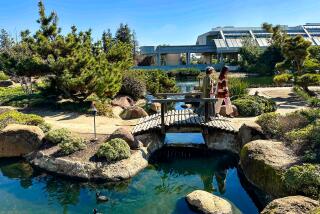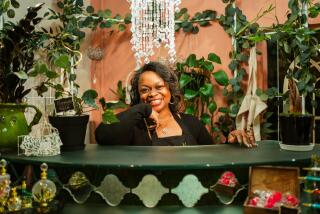Irish spa offers seaweed serenity
I was sitting on the banks of the Garavogue River in Sligo on a spring day last year when a local woman parked her bike and sat down next to me. We chatted about this and that, and then she asked whether I liked spas. It was like asking Santa whether he liked reindeer.
“I find most spas very fussy,” she said, “but I think you’d find the Voya seaweed baths in Strandhill really different. It’s less than 10 kilometers from here.”
Because locals are my favorite guidebooks, I jumped into my rental car, and off I went.
Planning your trip
Voya Seaweed Baths, 011-353-71-916-8686, www.voyaseaweedbaths.com, $36 for 50 minutes for a single private room.
Carrowmore Megalithic Cemetery, 011-353-71-916-1534. About 2 1/2 miles from Sligo’s town center.
Strandhill is a lively little seaside resort with the requisite surfers, ice cream and T-shirt shops, pebble and sand beach, wooden boardwalk and a view over the shore-seeking waves of the Atlantic. Across from the sea, a sign on a low, off-white building with a modern glass entryway read: Voya Seaweed Baths.
Inside, at the reception desk, two friendly young women were surrounded by Voya spa products.
I quickly envisioned another ho-hum spa experience with some expensive essence-of-seaweed extract drizzled into a tub of hot water.
Wrong. Nicola, one of the two women, handed me a towel, robe and slippers and escorted me to a private bath room. She flipped a switch to turn on a steam shower.
“Please go into the steam for five to 10 minutes,” she said, “and switch it off when you are done. Then go into the bath for 30 to 35 minutes. The cold water is salt water. Rub it all over your skin, hair and face to release the oils.
“Then pull the plug in the tub, scoop up the seaweed and put it in a bucket. Remember to drink plenty of water, and you’ll find the bath is excellent if you are stressed or overworked.”
Whenever I am given multiple instructions, I manage to get them muddled and I end up talking to myself, trying to repeat what I was supposed to do. “Steam,” I said, as I entered the shower. “Bath,” I said, as I prepared for my soak.
When I looked into the white claw-foot bathtub, I thought I was hallucinating. It was filled with huge, long fronds of seaweed. I stepped inside and sank into the all-engulfing strands, afraid I would emerge half an hour later looking like Botticelli’s Venus if she had been strangled.
“You are stressed and overworked,” I told myself. “This is good for you.”
I wasted the first five minutes in the hot seaweed soup fretting because I had forgotten to turn off the steam shower. The next 15 minutes were spent in futile attempts at clearing my mind and relaxing. I ended up popping the seaweed pods as though they were bubble wrap. Then I picked up some of the slimy wild seaweed and ran it over my face and hair. Just as Nicola had promised, the oil of seaweed was released and I began to enjoy the glutinous, aloe-vera-like experience. I ran organic fucus serratus seaweed over every inch of me, actually giggling aloud, and when 35 minutes were up, I didn’t want to leave.
I remembered to scoop out the seaweed with my now-soft hands and place it in a wooden bucket, where a sign told me it would go to fertilize a local organic garden. The experience felt as wholesome and Earth-friendly as buying a hybrid car.
When I returned, glowing, to the crowded reception area, I was surprised to meet Ben, age 3 1/2 , and 1-year-old Celine waiting with their parents, Noel and Moya Quinn, to enter a bath room. Who brings a toddler to a spa in America? Parents go there to get away from their kids. Nicola told me that the youngest seaweed bather they had hosted was a few days old. “Of course, the kids don’t go in the steam shower,” she said.
More than 40,000 people come to Voya each year for the seaweed bathing experience. A century ago, bathing in wild seaweed -- which was touted for its minerals, vitamins and trace elements -- was all the rage in Ireland. There were more than 300 bathhouses throughout the country, and nine in little Strandhill. In 1961, Hurricane Debbie destroyed the last of them. People left the Atlantic coast, and nonorganic spas throughout the country catered to the soak-loving population.
But organic is back. A family named Walton revived the tradition of the old baths in Voya about 10 years ago. Papa Mick comes from generations of organic farmers and was one of the founders of the organic movement in Ireland. He practices sustainable harvesting with limited environmental impact and uses the wild seaweed as fertilizer. Does it work? Ask son Michael, whose products won the All Ireland Vegetable Championships. Son Neil, a former triathlete, had a business head on his buff shoulders and launched the family spa in 2000. And Mark, another son, is credited with creating Voya, the world’s first seaweed-based organic products.
A side trip to a prehistoric site
Relaxed and unstressed, I was on my way back to Sligo when I saw a sign that pointed to Carrowmore Megalithic Cemetery, among the most important such sites in Europe. My car screeched to a halt; prehistory is one of my passions. Archaeologists have found more than 60 tombs at Carrowmore, and although it was late afternoon, I determined to visit as many as I could. The small exhibition building was already closed, and no one else was there. A well-trodden grass path led out into fields that were dotted with dolmens (single-chamber tombs, generally featuring several upright stones that support a large, flat, horizontal capstone) passage tombs (single or multichambered tombs, sometimes covered with cairns) and rings of stone.
The path wound around past stone walls and rich green fields where horses grazed. Without warning, dark gray tombs appeared in the landscape. These stones would tell tales of ceremonies and sadness, death and loss. The wind picked up, and I imagined I heard wails of women and men, mourning for the departed on these hallowed grounds.
I walked on and gasped when I saw a huge stone cairn made of large rocks at the bottom, and smaller and smaller ones toward the top of the meatloaf-shaped structure. I entered an opening and followed a passageway lined with tiered stone walls that led to a burial chamber containing a tomb so large it must have been for royalty -- like the king’s chamber in the Pyramid of Cheops on the Giza plateau in Cairo.
I spent a long time inside the cairn, wondering how many people and how much labor was required to construct such a tomb. It must have been a communal effort. Who were the builders? Who was the leader? Was he kindly or tyrannical? The mooing of a cow in the distance was the only answer.
As I finished walking the path and headed for my car, I saw a man with a backpack and camera across the road. Behind him were more fields with tombs. I ran there to beat the dusk, excited to find more circles or rings of stone with dolmens in the center. Each was different; some had more stones and some fewer. It took little imagination to conjure up an extensive cemetery where loved ones were offered back to the earth.
When it was almost dark, I got into my car and saw the man with the camera looking through his digital megalithic treasure-trove.
“Did you get to Knocknarae mountain?” he asked me. “That’s where Queen Maeve’s grave is. You must go tomorrow.”
But when tomorrow came, I had left the Sligo area and decided that one day I would come back to visit Queen Maeve and the wondrous world of megaliths.
More to Read
Sign up for The Wild
We’ll help you find the best places to hike, bike and run, as well as the perfect silent spots for meditation and yoga.
You may occasionally receive promotional content from the Los Angeles Times.






